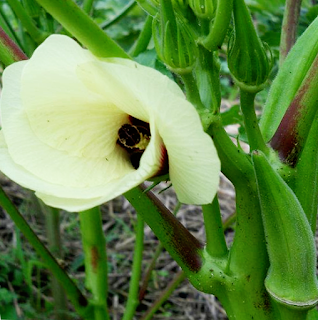Okra Production in the Philippines
Okra Production
Okra or okro has the scientific name Abelmoschus esculentus. It is called in English as ladies' fingers (mainly due to resemblance to female fingers), gumbo or ochro. Okra is also known as saluyot a bunga in Ilocano and kaluyot in Ifugao in the Philippines. Okra is a flowering plant in the mallow family. It is valued for its fruit that is an edible green pods when still immature. The geographical origin of okra is disputed, of which South Asian is believed to be the origin due to occurrence of proposed parent which is believed to be Abelmoschus ficulneus. Okra production in the Philippines is stable as the crop is very easy to grow and the seeds are readily available.
Raw okra is 90 percent moisture, 7 percent carbohydrate, 2 percent protein and low fat percentage. In a 100 gm fruit of Okra, the raw edible parts is abundant in dietary fiber, vitamin K, Ascorbic Acid with moderate contents of Vitamin B1, magnesium and folate.
Okra Recipes
Okra can be prepared for human consumption in a variety of ways.
It can be prepared by boiling, blanching, roasting, or by preference raw, and served with sauces for added flavor. Fish paste complements the crunchy texture of the immature fruits which is has goo or slime like consistency of its juice.
It can be cooked into stews together with other vegetables like eggplant, squash, patola or luffa, and bitter guard. Fish sauce is added for flavor if it is a binaggoongan dish. It can also be served in stir fry. It can also be served as ginisa or sautéd or cooked in oil with garlic and onions.
The dried seeds of the okra plant can be turned into a coffee alternative due to its reach aroma when roasted and grilled into coffee like powder.
Okra Cultivation and Production Guide
1. Planting and Land Preparation
Propagation by seeds is the method currently predominant since it is simple and the seeds are not required to be grown into seedlings. Seeds are collected from a dried mature fruit which is easy to split to get the seeds inside. Typical seed count is 100 to 200 pieces of seeds per medium sized fruit. The dry seeds are sown on the prepared furrows and covered with earth around 10mm thick enough to cover the seeds. Germination is fast at 1 week time . Seeds can be sown directly in flats of soil, seedbeds or in small containers. Land preparation for okra is similar to other farm crops in which fields are cleared , by removing weeds and grasses. One advantage of okra is simultaneous land use. Rice can be grown in the main field, and okra is planted on the sides. For commercial and upland planting, loosen the soil to ensure proper growth of the root system. Tractor can be used or manual preparation by using plow.
2. Fertilizers
Fertilizers are applied when the Okra plants are about 1-2 feet high to improve soil nutrients. Early application of fertilizer also can be done, but with minimal amount. Complete fertilizer or 14-14-14 which has equal amounts of nitrogen, phosphorous, and potassium. Organic farming can be adopted by using with chicken manure organic compost. Apply 0.5-1 tablespoon per okra plant. Okra requires proper sunlight exposure to allow photosynthesis. During dry season, irrigate the crop by water hose. Repeat irrigating at nine to ten days interval throughout the growing season when there is no precipitation. This will allow the trees to absorb water for growth and fruit development. Okra are bit tough and adaptable to irregular precipitation. It can survive long time of no rain, and also heavy rains. Storms may affect the okra garden, but the resilience of okra is seen with just applying fertilizer for plant recovery.
3. Soil cultivation
Soil cultivation can be done once every 3 months along with fertilizer.. This is important to loosen the earth around the plan. Mulching can be applied as well. Removing weeds must also be done in line with cultivation.
4. Pest and diseases
Pest and disease can be controlled. Pests includes green leafhopper, jassids, stink bugs, and stem borrer. Stem borrer are a bit difficult to control by spraying pesticides as the worms burrow deep into the plant stem. Use pesticides to control them and observe the signs of infestation and practice manually removing infected plant parts. Apply pesticides when there is no rain to prevent washing away of the pesticides. Practice crop rotation to break the cycle of disease proliferation. Disease of the plant include Cercospora blight, fruit rot, and powdery mildew. If left uncontrolled, the okra will turn yellow and may die. It may also lead to low productivity crop.
Okra Fruit Harvesting
Harvesting is good during early morning or late afternoon when there is still sunlight. This prevents the harvest from wrinkling. Proper picking and harvesting attire is needed as the plant leaves of Okra will cause irritation of skin. Collect the fruits in baskets and it can be harvested every 3 days to avoid maturing of the fruits, which cannot be sold. Okra prices can be Php 5.00 to Php 20.00 per bundle depending on supply and demand.





Comments
Post a Comment